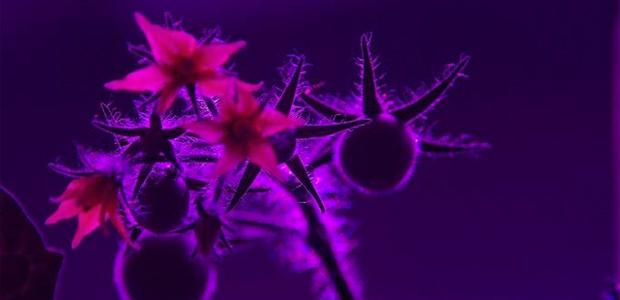Video: Indoor Farming is a ‘Plant Paradise’ in the Netherlands
Growing tomatoes at the PlantLab in the Netherlands (Photo: PlantLab)
Any gardener will tell you that healthy plants need plenty of sunshine, water and fertilizer. Of course, these days much of the fruit and vegetables that we consume are grown in ways that challenge those fundamental notions.
Large greenhouses, for instance, often eschew natural light for light produced by lamps. And Japan and South Korea are trying to create urban greenhouses that bring produce a bit closer to those who eat it. But now, a Dutch company called PlantLab is trying to take urban growing one step further.
“Plants are very clever organisms,” says Gertjan Meeuws as he leads me into PlantLab’s research facility in Den Bosch. “They behave from a very balanced way of thinking.”
PlantLab’s growing rooms are, as you might expect, hot and humid. No natural light comes in here. Instead, tiny blue, red and white LED lights shine in rows above small potted orchids. Air conditioning helps whisk away the excess heat generated by the lights.
“We can change temperature, carbon dioxide levels, or humidity,” Meeuws says. “We can even influence how products taste and nutrient value by playing with light and climate.”
Meeuws and his partners at PlantLab have been studying how plants grow for more than two decades. One of the strange things he and his team have discovered is this: nature often upsets a plant’s balance.
“We started realizing that plants are so intelligent and so productive, that it should be possible to create a surrounding, a building, that allows them to be much happier than outside or even in a greenhouse. We started developing a building to make plants very, very happy.”
PlantLab calls it “plant paradise.”
Light is split into wavelengths most conducive to growing, and the climate is closely controlled. Water use is kept to a minimum, Meeuws says, and they don’t use pesticides.
It’s all monitored by an “operating system” that Meeuws says fits on a computer flash card.
PlantLab claims to be growing fruits and vegetables much faster than conventional greenhouses.
“The first reaction you normally get in this case is baloney. That’s impossible,” says Olaf van Kooten, who studies horticultural supply chains at Wageningen University in the Netherlands.
Van Kooten says he was skeptical of PlantLab’s claims at first, but then he accepted an invitation to see what the company was doing.
“When I examined their production, I saw differences in rate of development of up to a factor of five, and that’s incredible. And I saw it with my own eyes. I haven’t been able to measure it yet, but what I saw was very impressive.”
PlantLab’s Gertjan Meeuws sees the Plantlab technology as a way to move closer to locally produced food.
“An average kilogram of tomatoes travels an average of 1,300 miles from growing area to store shelf. It’s ridiculous,” Meeuws says. “It has become an industry with food supply chain management. And that’s a difficult realizing that you have to eat what comes out of it. It should be produced around the corner.”
Meeuws says that with PlantLab’s system, one can imagine basements and unused office space in large cities filled with level after level of fruits and vegetables.
Tomatoes and strawberries, he says, could be grown right around the corner from where they are sold.
But for now, PlantLab’s system costs a lot more than traditional growing methods, largely due to the costs of getting rid of the excess heat generated by the LED lights. The company is confident that will change as LED lights become more efficient and produce less heat.
Olaf van Kooten says he doesn’t expect PlantLab’s technique to solve to the world’s food problems, but that countries like China might find it attractive.
“China already has too little soil for its own food production, and that’s why they’re buying land in Africa. It’s very possible they’ll use these techniques as part of their solution.”
Maybe, but what about the taste?
I get a hold of Pat Van De Wall Bake-Thompson, who runs a private restaurant and cooking school in Amsterdam. She recently went to PlantLab to sample some herbs.
“I went completely open-minded,” Bake-Thompson says.
She says she sampled basil, lavender and two varieties of parsley – flat leaf and curly.
“I usually say to my students – ‘curly parsley you put in your hair, and flat-leaf parsley you eat.’ But PlantLab’s curly parsley was delicious. I was quite impressed.”
Bake-Thompson may soon get the chance to try something grown a little closer to home, as PlantLab plans on building a “city farm” in Amsterdam in the coming months.
The company is also working on a growing unit the size of a microwave oven.
